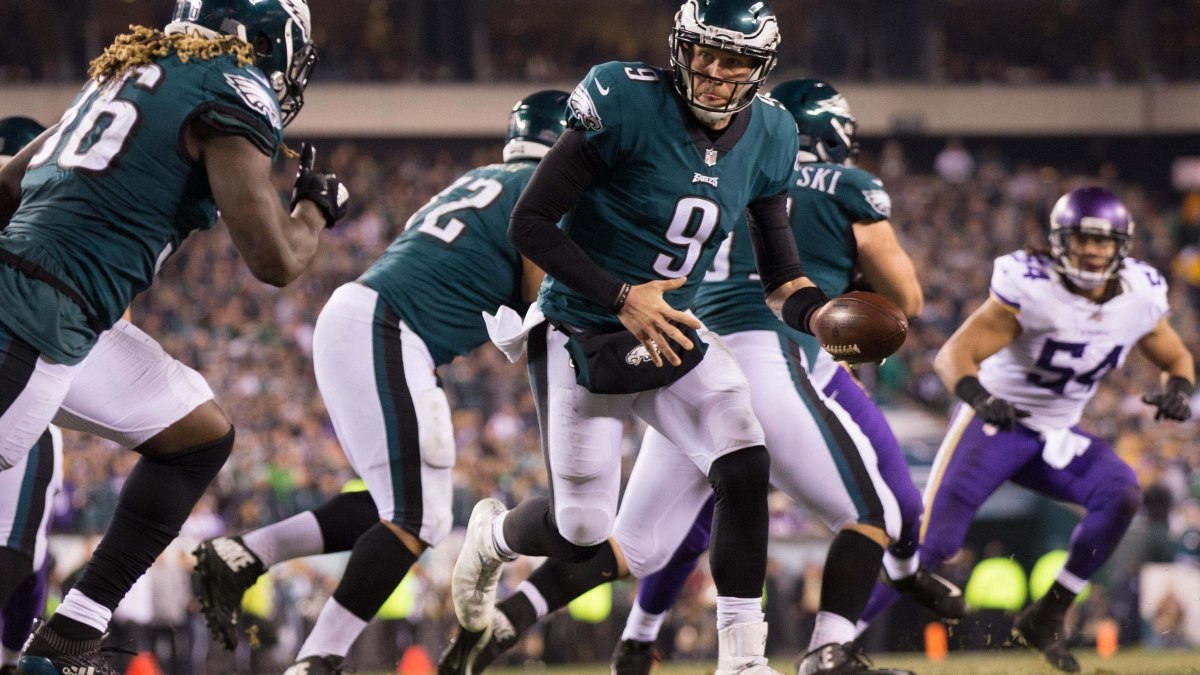This Sunday night you’ll hear my boss, Cris Collinsworth, say the letters R.P.O. no fewer than a dozen times. It’s the newest NFL buzz word that you’re probably sick of at this point. Collinsworth won’t simply be saying it to sound cool though, it’s likely a concept that will decide the outcome of Super Bowl LII.
The Eagles ran more run pass options (RPOs) this season than any team in the NFL. Senior Analyst Sam Monson broke down exactly how the Eagles utilize the plays after quarterback Carson Wentz tore his ACL, and came to the conclusion that the injury wouldn’t be a death knell to their season because of the RPOs. Obviously, that’s come to fruition in the weeks since and their ability to manufacture yards via scheme is a big reason why.
The Eagles have run 207 RPOs (league average was 66) on the season and gained 981 yards on those plays. They aren’t incredibly efficient, averaging just a shade over the league average of 4.68 yards per play, but when you consider it as an extension of the running game, that goes a long way in keeping an offense on schedule. They’re also about to face a New England defense that was absolutely gashed by the exact same RPO again and again against the Jaguars.
Will be interesting to see how the Pats gameplan for the Eagles RPOs. Jaguars shredded them with same RPO 4 times in first half last week pic.twitter.com/gYJWIPYIjj
— Mike Renner (@PFF_Mike) January 30, 2018
Doug Pederson and company aren’t above stealing plays from others and they undoubtedly know the Pats struggled with this in the AFC Championship. With a heavy dose of RPOs in the forecast, how then do the Patriots game plan to stop them?
The key for the Patriots – or any team looking to shut down the RPO – is to force the handoff. League-wide, the average yards per play on RPO passes is 5.1 while it’s only 4.5 on runs. Take away the pass option, and it’s far less deadly. If played correctly, once the ball is handed off, the defense should still have enough in the box to stop the run. The Patriots did a solid job of that for most of the season with only 14 RPO passes attempted against them – the seventh-fewest in the league. One of the easiest ways to do that, is by simply playing man coverage. The league-wide numbers on RPO passes versus man and zone are shown below.
| Man | Zone | |
| Comp % | 68.9% | 88.3% |
| YPA | 4.97 | 5.82 |
The main reason for this large discrepancy is due to one of the core philosophies of the play. As I stated last offseason when analyzing the Bengals usage of RPOs, the play works to isolate a ‘conflict’ defender. That is, a defender that has both run and pass coverage responsibilities (Elandon Roberts running the wrong way on the Leonard Fournette handoff above). When you play man coverage, these players either don’t exist, or have much more defined reads. As you can see in the play below, the Pats are in man coverage so Stephon Gilmore is completely unfazed by any run fake. He’s free to break on the pass immediately and the play goes nowhere.
One thing I expect is a lot of man coverage from the Pats. Not only do they match up well with Gilmore v Jeffery and Butler v Smith, but it takes away the pass option on RPOs much of the time pic.twitter.com/rrDdNgR5EI
— Mike Renner (@PFF_Mike) January 30, 2018
The Patriots already do play man coverage at the second-highest rate in the NFL (51.7 percent of snaps). I’d expect them to play even more against the Eagles considering the struggles the Patriots had when trying to play zone last week. It will put stress on the defensive line to make plays on Jay Ajayi and LeGarrette Blount, but it’s preferable to letting Nick Foles get in a groove like he has been the past two weeks.



 © 2024 PFF - all rights reserved.
© 2024 PFF - all rights reserved.